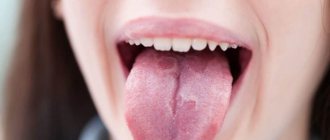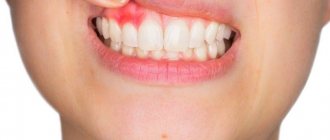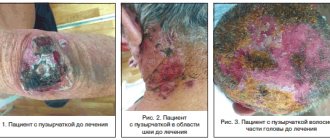Causes
Unlike ordinary sore throat, herpetic sore throat is caused by viruses. Among the main provocateurs, it is worth highlighting the Coxsackie virus type A or B, serovars, and ESNO viruses. They can be infected by droplets, fecal-oral routes, through bodily contact, and unprocessed food.
The pathogen, entering the body, multiplies in the intestines and lymph nodes. The pathogen spreads through the lymph and blood and intensively accumulates in the pharyngeal ring and tonsils. On the third day, the condition of the infected person deteriorates sharply.
Symptoms
The following clinical picture appears sharply, acutely and violently:
- Within a few hours the temperature rises to 40°C.
- Chills and general weakness of the body appear.
- My head starts to hurt.
- When swallowing saliva or liquid, an unbearable sore throat develops.
- The color of the mucous membrane of the nasopharynx changes. After a few hours, the throat turns red, and the next day it becomes covered with many reddish blisters.
Acute symptoms last for 2-3 days, and then their intensity decreases.
Symptoms of the disease
Sore throat or acute tonsillitis have a pronounced clinical picture. The incubation period lasts from 12 to 48 hours, after which clinical signs appear.
- Increased body temperature (above 39°C, less often 37-38°C). With a sore throat, it is difficult to lower a high body temperature with the help of antipyretics.
- Signs of intoxication are body aches and weakness, headache, chills, dizziness, pain in the chest and heart area.
- Pain and sensation of a lump in the throat. Pain when swallowing.
- Hoarseness of voice.
- Inflammation of regional lymph nodes.
On examination, swelling and hyperemia of the palatine tonsils are revealed. Depending on the type of inflammation, purulent plaque forms on the lacunae or all tonsils.
In some cases, the symptoms of the disease may not be expressed. The temperature may remain within the low-grade range or slightly elevated, accompanied by unpleasant and painful sensations in the throat.
Symptoms of herpetic sore throat in children
Children attending nurseries or kindergartens, as well as schoolchildren, get sick most often. In children in the first three years of life, herpetic sore throat is extremely difficult, since the first signs of the disease are similar to the flu.
In addition to the general signs of intoxication, children appear:
- Temperatures up to 41°C.
- Pronounced hyperemia of the mucous membranes of the mouth and pharynx. During examination, the tissues appear to be filled with blood.
- A day later, 1-2 mm papules in the mouth, surrounded by a red rim. The next day they open, forming ulcers with crusts.
- Runny nose.
- Decreased appetite due to impossible pain.
- Enlarged lymph nodes located in the neck and ears.
If children have weak immunity, then sore throat occurs in waves, i.e. The deterioration of the condition is recorded after a few days, then it improves noticeably.
In addition, children experience stomach upset due to the fact that viruses irritate the mucous membrane of the digestive tract. The child complains of diarrhea and nausea.
Standard Treatments
Since the inflammatory process develops in an open form and is local in nature, rinsing for necrotic sore throat is necessary. One of the best options is to treat the tonsils with hydrogen peroxide (3 percent solution). Potassium permanganate, furacillin and potassium chloride also help well. You need to gargle as often as possible, at least 6 times a day.
Doctors prescribe antibacterial drugs for the progressive course of necrotizing tonsillitis. Groups of antibiotics can be as follows:
- penicillin;
- cephalosporin;
- macrolides.
The first group consists of all penicillin drugs (including amoxicillin), from the second group cefazolin is often prescribed. The third group is represented by erythro- and clarithromycin. It is she who is the safest of all the others. Side effects when using macrolides are minimal, so they can be prescribed in childhood.
The patient should also stay in bed and eat well. Antipyretics are used as symptomatic treatment.
If the sore throat is very severe or recurs, the issue of surgical removal of the tonsils should be raised.
Diagnosis and treatment
At the appointment, the ENT doctor will examine the patient and conduct an examination. Based on the diagnostic results, drug therapy is prescribed, including:
- Taking antipyretics based on paracetamol or ibuprofen.
- Taking antiviral drugs prescribed after identifying the exact pathogen.
- Taking antihistamines. The active substance helps relieve swelling and ease breathing.
- Resorption of lozenges, lozenges, use of local sprays. Their antiseptic and bactericidal properties reduce sore throat.
- Local use of antiviral ointments based on interferon.
- Taking immunostimulants to activate the body's defenses to fight the pathogen.
It must be emphasized that antibiotics are powerless for this type of tonsillitis, because they do not affect the reproduction of viruses.
Important to remember! Do not apply heat compresses to the throat. Heating promotes the further spread of viruses throughout the body.
In addition to taking medications, the patient must be isolated from others and observe strict quarantine. The infectious period lasts two weeks. You need to follow a diet and eat pureed liquid food, drink more liquid. Water not only prevents dehydration, but also relieves symptoms of intoxication. If you are sick, you should not smoke, drink boiling water or water from the refrigerator.
Since the throat is constantly injured, healing occurs within 10-14 days. Crusts and sores are washed off with saliva without any residue.
It is important to know! Do not touch the bubbles with your hands or try to squeeze them out.
Treatment of the disease
In most cases, treatment is carried out on an outpatient basis. Patients are prescribed bed rest, warm, plenty of fluids, and food should be light and liquid. Treatment, depending on the type of sore throat, includes antibacterial therapy, antiviral drugs and local symptomatic treatment. Additionally, the tonsils are irrigated with anti-inflammatory drugs, gargling with herbal decoctions and antiseptic solutions. To reduce swelling and symptoms of intoxication, antihistamines are indicated. The course of treatment is 5-10 days.
Specific features of herpetic sore throat
Herpetic tonsillitis can be distinguished from other types of sore throat by the following characteristics:
- A rash appears on the upper and lower extremities and face if not treated in a timely manner.
- Numerous red blisters appear on the pharynx, adenoids, tongue, and palate. Gradually they develop into ulcers and open. A light transparent exudate emerges from the bubbles. Typically there are from 5 to 20 ulcers in the mouth. If treatment is not started in time, the ulcers merge with each other, forming large areas of damage to the mucous membrane of the throat and mouth. In this case, there is a high risk of complications.
Often, parents mistake herpangina for another disease and try to cure it on their own. Herpetic sore throat should not be confused with:
- Thrush. Candidiasis in the mouth appears as a cheesy coating.
- Herpetic stomatitis. Papules are similar, but with stomatitis they are localized on the gums and tongue.
- Purulent sore throat. Formations accumulate only on the tonsils and lacunae, and with herpetic disease they cover the entire nasopharynx. In addition, a runny nose is a distinctive symptom. With purulent tonsillitis there is no runny nose.
Causes of stomatitis and symptoms of the disease
Stomatitis on the oral mucosa and tongue occurs in humans for various reasons. Some of them are local in nature and are associated with the penetration of various bacteria or viruses into the oral cavity. In other cases, the formation of stomatitis ulcers on the tongue occurs against the background of decreased immunity and general weakening of the human body.
Let's name the most common causes of stomatitis in the tongue:
- Oral injuries. They can occur as a result of a person eating hot, hard or sour foods. Damage to the mucous membrane can trigger a stomatitis reaction and cause the formation of ulcers on the tongue, characteristic of this disease.
- Infections. Here we are talking about viral and bacterial diseases of the human oral cavity, which in themselves do not cause stomatitis. It is only the body’s reaction to the occurrence and development of these infections. In 90% of cases in such a situation, stomatitis caused by the herpes virus develops on the human tongue. It manifests itself in the form of small blisters that burst after 3 days, accompanied by severe pain and an increase in the person’s body temperature.
- Weakening of the immune system. Weakening of the immune system as a result of stress, acute illness (for example, a cold) or chronic diseases (helminthic infestation, giardiasis, etc.) provokes the formation of stomatitis ulcers in the human oral cavity.
- Poor oral hygiene. The surface of the human tongue provides an excellent environment for the growth and reproduction of bacteria. Therefore, daily brushing of teeth and treating the oral cavity with antiseptic solutions is the best way to avoid the development of infectious diseases that can provoke the appearance of stomatitis ulcers on the surface of the mucous membrane and tongue.
- Avitaminosis. Lack of microelements negatively affects the condition of the human body. Therefore, with a lack of vitamins A, B and C, folic acid, iron and other substances, the risk of stomatitis in a person’s mouth increases.
- Using toothpastes containing sodium lauryl sulfate. This substance is included in many products intended for human oral hygiene, since it promotes the formation of abundant foam. But sodium lauryl sulfate dries out the mucous membrane, as a result of which it becomes susceptible to damage, which can cause stomatitis.
Local and general causes of stomatitis are interconnected. One problem leads to another and causes a subsequent reaction. Thus, a weakened human immune system provokes the development of an infection, against the background of which stomatitis occurs on the tongue. Therefore, comprehensive measures are necessary to treat and prevent relapses of this disease.
Complications
Unfortunately, this type of tonsillitis has dangerous negative consequences if the disease is started and left to chance. The greatest danger is from complications of the kidneys, brain and heart. Since the sore throat virus spreads through the flow of lymph and blood, inflammation can overtake certain parts of the brain, causing meningitis and encephalitis. Convulsions, persistent headache, increasing temperature are reasons to seek medical help again.
At the ENT CLINIC in Chertanovo, ENT doctors with extensive experience will carefully examine an adult and a small patient and immediately perform a serological and virological analysis to determine the causative agent. The technical equipment of our medical center allows us to obtain diagnostic results within a couple of hours. Thanks to this, therapeutic therapy is prescribed in a timely manner, with positive dynamics occurring the very next day.
How to cure stomatitis on the tongue?
At the first signs of stomatitis, specialists at the LeaderStom clinic recommend contacting a dentist for diagnosis and prescribing appropriate treatment. A person’s attempt to cope with a stomatitis disease that appears on the tongue on his own may not only not lead to the desired result, but on the contrary, increase the symptoms of the disease. The drugs that are used to treat stomatitis on the tongue can be divided into local therapy drugs and medicinal formulations that have a general effect on the human body. Let's take a closer look at each of these forms.
Treatment of stomatitis with local therapy:
- Treatment of stomatitis ulcers on the human tongue with antiseptic gels, ointments and sprays.
- Rinsing the mouth with antiseptic solutions, which can be purchased at the pharmacy (chlorhexidine, miramistin, etc.) or prepared yourself using medicinal herbs such as chamomile or calendula.
- In order to relieve the pain symptom, doctors recommend using local preparations containing lidocaine for a person with stomatitis formations on the tongue.
General therapy for stomatitis:
Depending on the cause that provoked the stomatitis disease, antibacterial, antiviral, antifungal or antihistamines are used. Such drugs are prescribed to a person only by a dentist or therapist. To relieve the symptoms of stomatitis, modern antipyretic and painkillers are used.
Taking vitamin complexes allows you to compensate for the lack of essential microelements in the body, which for one reason or another a person does not receive with food, and vitamin deficiency, as is known, is one of the factors that can provoke stomatitis on the oral mucosa and tongue.
For stomatitis, immunomodulatory drugs are also used - drugs that increase human immunity. They can be of both plant and medicinal origin. All patients, regardless of the reasons that caused stomatitis on the tongue, are recommended by doctors to take these medications.
Drugs are also used to treat somatic diseases. The use of such remedies is necessary if the cause of stomatitis on the tongue lies inside the body. Chronic diseases of certain systems, and especially the human gastrointestinal tract, weaken the body and contribute to the launch of an immune reaction, manifested in the formation of stomatitis ulcers on the palate and tongue.











